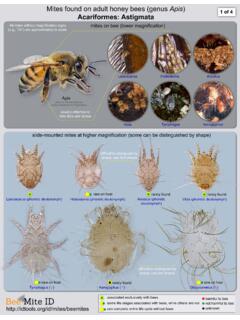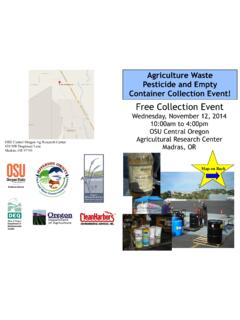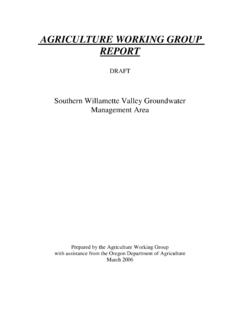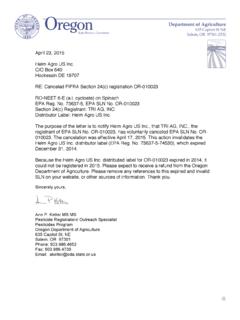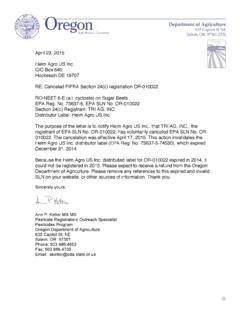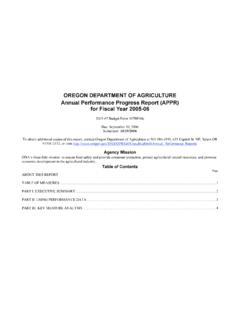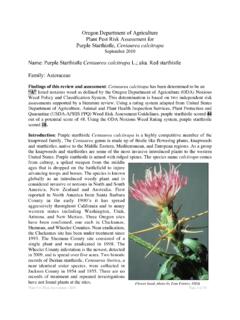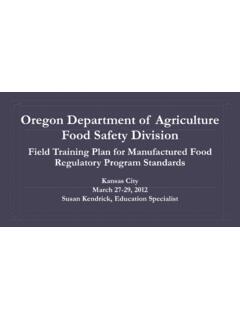Transcription of Oregon Department of Forestry: Aerial Pesticide ...
1 Oregon Department of Forestry: Aerial Pesticide Application Monitoring Final Report Liz Dent Monitoring Unit Manager Joshua Robben Monitoring Specialist Oregon Department OF FORESTRY FOREST PRACTICES MONITORING PROGRAM TECHNICAL REPORT 7 March 2000 ii Acknowledgements The assistance and cooperation of private landowners, Pesticide applicators, representatives of the environmental community, Oregon State University (OSU), Oregon Department of Forestry (ODF) field staff, the Oregon Department of agriculture (ODA) laboratory, and community water managers were instrumental in designing and implementing this project. The Chemical Rules Subcommittee (listed after the table of contents), Paul Bell, and Jenny Walsh were all instrumental in the study design and implementation of this project. Kyle Abraham, Erin Gilbert, Amber Kubischta, Yvette Frazier, Kevin Tuers, Dave Ryland, Mike Kroon, Laura Ramme, and Jenny Walsh were all responsible for data collection.
2 Ray Gress, Peg Foster, and Jan Pugh provided valuable project support. Charlie Stone, Ted Lorensen, and David Morman prioritized this project for the monitoring program. This project would not have been possible without the participation of private landowners and operators including Boise Cascade, Cascade Timber Co., Evenson Timberland Agency, Longview Fibre, Menasha Timber, Roseburg Forest Products, Simpson Timber, Starker Forests, Western Helicopter, Shannon White, and Willamette Industries. Thanks to Dave Pederson and the ODA lab for their expertise and timely analysis of the samples. The authors would also like to thank all the forest practice foresters and ODF State Lands personnel who made the site selection process possible, contacted landowners, and arranged logistics to support the field teams. i Table of Contents Chemical Rules Subcommittee .. I Introduction .. 1 Rules and Regulations.
3 1 Forest Practices Monitoring Program .. 2 Past Findings With Regard to Aerial Application of Pesticides .. 2 Water Sampling Results .. 2 Peak Concentrations Generated By Precipitation .. 3 Study Design .. 4 Monitoring Questions .. 4 Water Quality Sampling Design .. 4 Riparian Vegetation Protection .. 6 Site and Operation Characteristics .. 6 Evaluation Methods .. 12 Protection of Water Quality .. 12 Protection of Riparian Vegetation .. 12 12 Protection of Water Quality from Drift Contamination .. 12 Operation Characteristics for Sites with Drift Contamination .. 13 Protection of Water Quality from Runoff Contamination .. 13 Protection of Riparian Vegetation .. 13 Summary and Conclusions .. 18 Recommendations .. 19 References .. 21 Appendix A: Pesticide Label Information, and Field Forms .. A-1 Appendix B: Pesticide Application Operational Data .. B-1 Appendix C: Site Maps .. C-1 ii Tables: Table 1. Site Characteristics.
4 8 Table 2. Weather Conditions and Operations Characteristics.. 9 Table 3. Target Pest, Chemicals Applied and Rate Information .. 10 Table 4. Surface Water Quality Criteria for Forest Chemicals.. 11 Table 5. Water Sample Pesticide Analysis Results .. 14 Table 6. Impacts to Riparian Vegetation from Aerial Herbicide Applications .. 17 Figures: Figure 1. Pesticide Monitoring Results From Three Studies in Washington and Oregon .. 3 Figure 2. Water Quality Monitoring Operation Locations.. 7 Figure 3. Concentrations of Pesticides Detected in 129 Post-Spray Samples from 26 operations .. 15 Figure 4. Pesticide Concentration Levels Detected in Water Samples from Sites 22 and 25.. 16 I Chemical Rules Subcommittee Monitoring Protocol Development Team Members Dave Pederson Oregon Department of agriculture Dr. Nancy Kerkvliet Oregon State University Bob Noelle Medford Water Commission Dr. George Ice National Council for Air and Stream Improvement Tally Patton Boise Cascade Corporation Dennis Ades Oregon Department of Environmental Quality Dick Miller Taxon Aquatic Monitoring Company Mark Gourley Starker Forests Norma Grier National Coalition for Alternatives to Pesticides Alan Brog Oregon Department of Forestry Dr.
5 Arne Skaugset Oregon State University 1 ODF Aerial Pesticide Application Monitoring Project Final Report January 2000 Introduction Forest pesticides, which include herbicides, fungicides, insecticides, and rodenticides, are commonly used to aid in the re-establishment, growth, and survival of forest tree species throughout Oregon . In 1997 the Oregon Board of Forestry revised forest practice rules governing application of pesticides and other chemicals (OAR 629-620). The rule revision process committed the Oregon Department of Forestry to monitor the effectiveness of the rules and report those findings to the Board of Forestry (OAR 620-620-700). In particular, the goal of this study was to test the effectiveness of the forest practice rules in protecting fish-bearing (Type F) and domestic use (Type D) streams from unacceptable drift contamination during Aerial applications of forest pesticides. This study was designed through a subcommittee of the rule revision committee.
6 The subcommittee members (page IV) represented the National Coalition for Alternatives to Pesticides, private landowners, Department of Environmental Quality, Oregon Department of agriculture , Oregon State University, city water commissions, National Council for Air and Stream Improvement, private monitoring consultants, and Oregon Department of Forestry. This subcommittee reviewed and approved the methods described and implemented for this study. Rules and Regulations The Oregon Department of Forestry (ODF) regulates forestry operations on non-federal forestland. Landowners and operators are subject to the Oregon Forest Practices Act when they conduct any commercial activity relating to the growing or harvesting of trees. The Oregon Forest Practices Act (FPA) was adopted in 1972. The overarching objective of the act is to: encourage economically efficient forest practices that assure the continuous growing and harvesting of forest tree species and the maintenance of forestland for such purposes as the leading use on privately owned land, consistent with sound management of soil, air, water, fish and wildlife resources and scenic resources within visually sensitive corridors as provided by ORS that assures the continuous benefits of those resources for future generations of Oregonians.
7 (ORS Policy, Oregon Forest Practices Act) The Oregon Board of Forestry has been vested with exclusive authority to develop and enforce statewide and regional rules. The forest practice rules are designed to address the resource issues identified in the FPA objective. The rules are categorized into divisions, and each division has a description of purpose. The purpose statements further refine the broad objectives of the rules and act. The focus of this monitoring project was on a subset of Division 620: Chemical and Other Petroleum Product Rules. The purpose of the Division 620 rules is to ensure that chemicals used on forestland do not occur in the soil, air or waters of the state in quantities that would be injurious to water quality or to the overall maintenance of terrestrial or aquatic life. While chemicals is defined in Oregon Administrative Rule 629-600-100 (11) as all classes of pesticides, plant regulators, petroleum products used as carriers, and adjuvants ( surfactants, control additives), this study only monitored herbicides and fungicides.
8 Note that the rule does not require that all measurable concentrations of chemicals in the waters of the state be avoided. Instead, the rule focuses on requiring best 2 management practices that are intended to ensure that chemicals do not reach the waters of the state at concentrations that could be injurious to water quality and terrestrial or aquatic life. In addition to compliance with ODF regulations, operations involving the use of pesticides are also subject to related laws administered by the Oregon Department of agriculture , Department of Environmental Quality, Occupational Safety and Health Division, Water Resources Department , and the Health Division (OAR 629-620-000). As stated earlier, this study focused on Aerial applications of herbicides and, to a lesser extent, fungicides. The rules regarding Aerial application of these pesticides maintain that operators shall only apply them under weather conditions that will protect non-target resources and comply with the product label (OAR 629-620-400 (3)).
9 Direct Aerial herbicide application may not occur within 60 feet of significant wetlands, Type F or D streams, large lakes, other lakes with fish use, and other areas of open water larger than one-quarter acre at the time of application (OAR 629-620-400 (4)). No herbicide application buffer is specified in the chemical rules for streams which are neither Type F nor D (Type N streams). However, all herbicide applications must be conducted in compliance with the product label and also ensure the retention of the riparian vegetation components required by the forest practices water protection rules. Direct Aerial application of fungicides may not occur within 300 feet of significant wetlands, Type F or D streams, large lakes, other lakes with fish use, other areas of open water larger than one-quarter acre at time of application, and within 60 feet of flowing Type N streams (OAR 629-620-400 (7)). This study focused on Type F and D streams, although three Type N streams were sampled.
10 These Type N streams had overstory vegetative buffers, a practice not required for Type N streams. See Table A-1 in Appendix A for details on buffer requirements for all Aerial chemical applications. Forest Practices Monitoring Program The Aerial Pesticide Application Monitoring Project is just one component of the forest practices monitoring program (Dent 1998) and is an example of effectiveness monitoring. A set of monitoring questions has been developed which guide monitoring efforts in determining if the forest practice rules are effective (effectiveness monitoring), implemented properly (compliance monitoring), and based on accurate assumptions (validation monitoring). The monitoring questions were formulated with significant input from the public and vested interest groups during the 1994 strategic planning process. The forest practices monitoring program currently coordinates separate projects to monitor compliance with forest practice rules and the effectiveness of forest practice rules with regard to landslides, riparian function, stream temperature, juvenile fish passage, and sediment delivery from forest roads.
